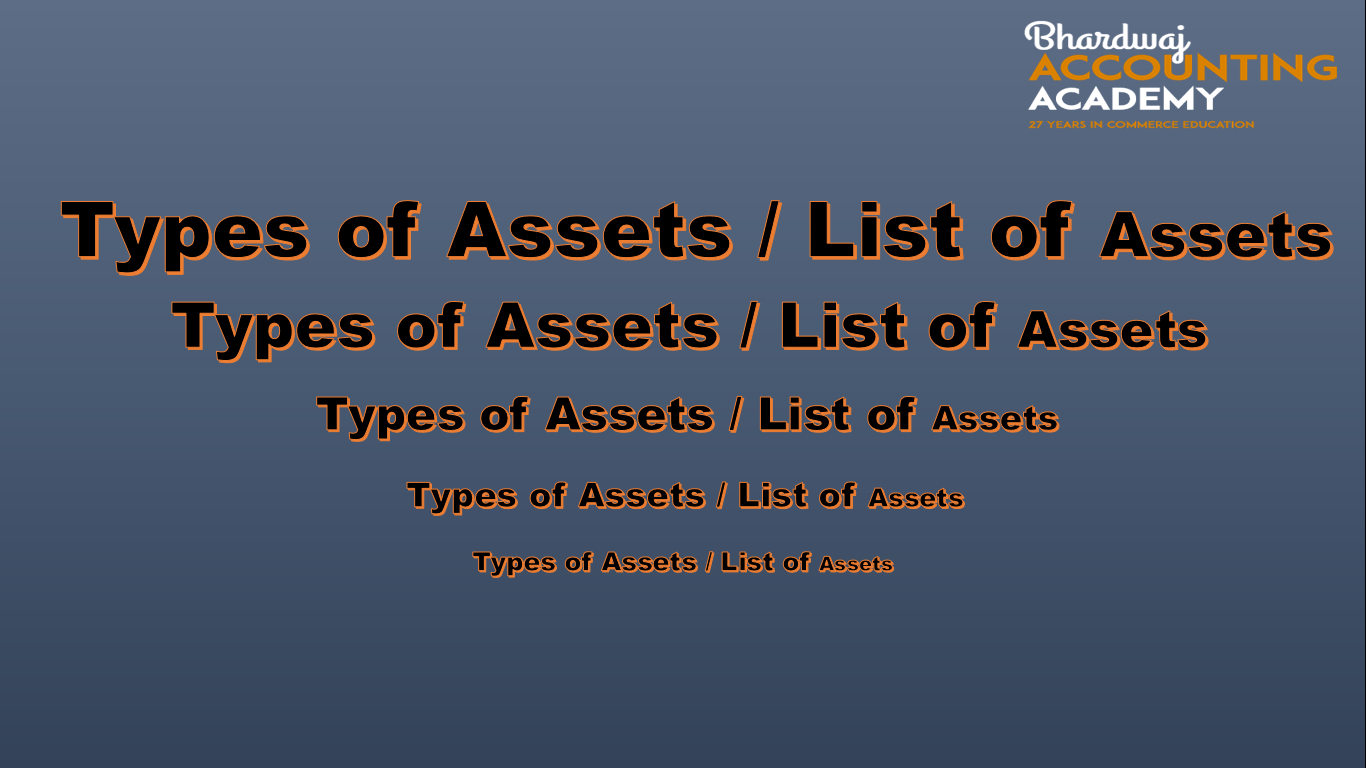Table of Contents
Types of assets/ list of assets
Types of assets/ list of assets
Assets
Assets are valuable and economic resources of an enterprise useful in its operations.
Or
Assets are valuable and economic resources of an enterprise, which can be expressed in terms of money.
Or
Assets are the properties owned by an enterprise.
Examples of Assets are Land, Building, Factory, Plant & Machinery, Furniture, Fixtures and Fitting, Furniture, Stock, Inventory, Debtors, Bills Receivable, Patents, Copyrights, Goodwill, Investment, Cash, Bank Balance, etc.
Definitions of Assets
According to IFRS (International Financial Reporting Standards), “An asset is a present economic resource controlled by the entity as a result of past events. An economic resource is a right that has the potential to produce economic benefits.”
According to US GAAP (Generally Accepted Accounting Principles used in the United States of America): “Assets are probable future economic benefits obtained or controlled by a particular entity as a result of past transactions or events.”
According to Prof. R.N. Anthony, “Assets are valuable resources owned by a business which are acquired at a measurable money cost”
According to Finney and Miller, “Assets are future economic benefits, the rights of which are owned or controlled by an organization or individual”
Characteristics of Assets
- It should be owned by the business.
- It may be tangible form or intangible form.
- It should have some value attached to it.
- It should have been acquired at a measurable money cost.
Types of assets/ list of assets
1. Non-Current Assets:
Non-Current Assets are those assets that are held for long period and used for normal business operation and are not for resale. For example– Land, Building, Machinery plant, furniture and Goodwill, Motor Vehicle etc. They are further classified into:
a. Tangible Assets
Tangible Assets are those assets that have physical existence and can be seen and touched. Examples of Tangible Assets are:
- Land,
- Building,
- Furniture,
Machinery, - Plant and Equipment,
- Motor Vehicles,
- Computers,
- Office Equipment,
- Fixtures and Fitting,
b.Intangible Assets
Intangible Assets are those assets that do not have a physical existence and can not be seen and touched, even they play an important role in the business. Examples of Intangible Assets are:
- Goodwill,
- Patent,
- Brands/Trademark,
- Copyrights,
- Mining Rights,
- Computer Software,
- Licenses and Franchise,
- Recipes,
- Designs etc.
Types of assets/ list of assets
2. Current assets:
Current Assets are those assets that are held for a short period of time and can be converted into cash within one year. The balance of such items goes on fluctuating i.e. it keeps on changing throughout the year. It includes the following :
The list of current assets are:
- Cash in hand,
- Cash at Bank,
- Trade Receivables(Bills Receivables and Sundry Debtors),
- Short term investment
- Marketable Securities,
- Inventories,
- Prepaid expenses,
- Accrued Income,
- Current investment,
- Cheques, Draft on hand,
- Short-term loans and advances.
Types of assets/ list of assets
3. Fictitious Assets-
Fictitious Assets are those assets that neither have any real value nor have any physical form, but are called assets on the basis of legal grounds.
Or
Fictitious assets are the expenses or losses which are not fully written off (not offset in the Profit and Loss A/c) during the particular accounting period. These are to be shown on the assets side of the balance sheet.
Fictitious Assets are neither tangible assets nor intangible assets.
Examples of Fictitious Assets-
- Advertisement Suspense Account,
- Discount on issue of debentures,
- Underwriting Commission,
- Preliminary Expenses,
- Profit and loss (Debit balance),
- Deferred revenue Expenditure,
- Expenses on issue of debentures,
- Expenses on issue of Shares etc.
Types of assets/ list of assets
4. Liquid Assets-
Liquid assets are those assets that can be quickly and easily converted into cash at a reasonable price. It includes the following:
Cash in hand,
Cash at Bank,
Cheque in hand
Draft in hand
Trade Receivables,
Short term investment,
Current investment,
Marketable Securities,
Liquid Assets = All Current Assets Except Inventories and Prepaid expenses, advance payment of tax.
